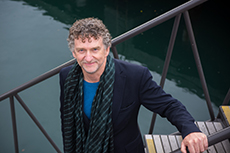Victoria expertise at UN summit on sustainable cities
A Victoria University of Wellington Professor of Landscape Architecture who helped design acclaimed public open spaces such as the capital’s Waitangi Park and Auckland’s Silo Park will soon contribute his innovative thinking to an influential United Nations (UN) blueprint for sustainable urban development.

A Victoria University of Wellington Professor of Landscape Architecture who helped design acclaimed public open spaces such as the capital’s Waitangi Park and Auckland’s Silo Park will soon contribute his innovative thinking to an influential United Nations (UN) blueprint for sustainable urban development.
Called the New Urban Agenda, the blueprint will offer countries guidelines on how to handle the problems and opportunities associated with the world’s cities given predictions they will nearly double in size by 2050 and become home to an estimated 70 percent of a global population of nine billion.
Professor Martin Bryant, from Victoria’s School of Architecture, is among experts from around the world recruited by the UN to use their “state-of-the-art research and analysis” to identify policy priorities for the New Urban Agenda and how best to implement them.
He was co-lead author for one of 10 policy units whose recommendations underpin the draft of the Agenda that will be voted on at the big UN Conference on Housing and Sustainable Urban Development in Quito, Ecuador, 15–20 October.
The conference, known as Habitat III, is the third of the UN’s 20-year global summits on sustainable urban development, with earlier ones held in 1976 and 1996.
Professor Bryant’s unit focused on urban ecology and resilience. At Victoria, he has researched and written extensively about how planning and design can makes cities more resilient against earthquakes, climate-change-related sea-level rises and other threats to their wellbeing.
Resilience is not just about being prepared for disasters, he says. “There’s a stream we call resilience to stresses as opposed to shocks. It’s about being generally healthy.”
Treating a city as an eco-system with all sorts of interdependencies that need respecting is one key to good urban health, says Professor Bryant. Another is planning and design that have the capacity to adapt to future changes.
Indigenous populations have an important role to play in strengthening a city’s resilience, he says.
As well as being an academic, Professor Bryant is a multi-award-winning practising landscape architect who has led, or contributed to, the landscape architecture element of many acclaimed public spaces in New Zealand, Australia and China.
In New Zealand, among the projects he worked on during his 10 years as a director and landscape architect at Wellington practice Wraight + Associates Ltd are Auckland’s Wynyard Quarter, including Silo Park and Jellico Street, the Christchurch Coastal Pathway, Rotorua Lakefront, Tauranga Waterfront and Rutherford and Trafalgar Parks in Nelson.
His and Wraight + Associates’ influence on the Wellington cityscape can be felt throughout the capital, from Otari-Wilton’s Bush to Waitangi Park to the current remaking of Frank Kitts Park incorporating a Chinese garden.
Anyone who has enjoyed leaping into the harbour—or watching other people do so—at Taranaki Wharf Jump Platform on Wellington waterfront has Professor Bryant to thank.
Professor Bryant sees such civic attractions as very much part of the resilience jigsaw. “It doesn’t sound like it’s about resilience but it is because it’s about how you create things in a public open space to get communities to operate together—to meet and generate that sense of ‘I want to be here and we’ll go through any problem we need to because it’s so good to be here’.”
He champions innovation over ‘betterment’—doing things the same way as before, just better. “I think we don’t really get resilience by being better, we actually get resilience by being innovative and doing things differently.”
